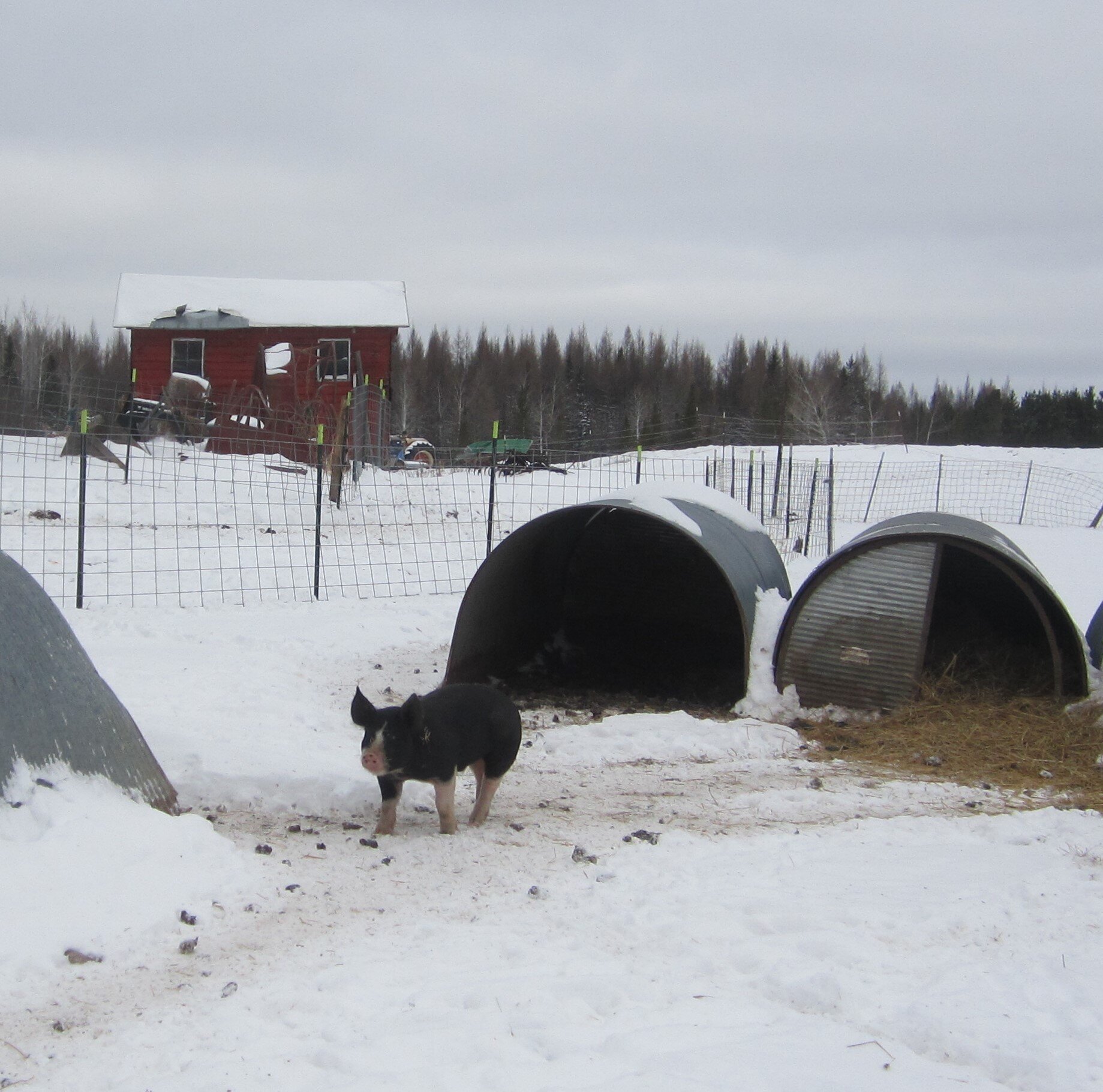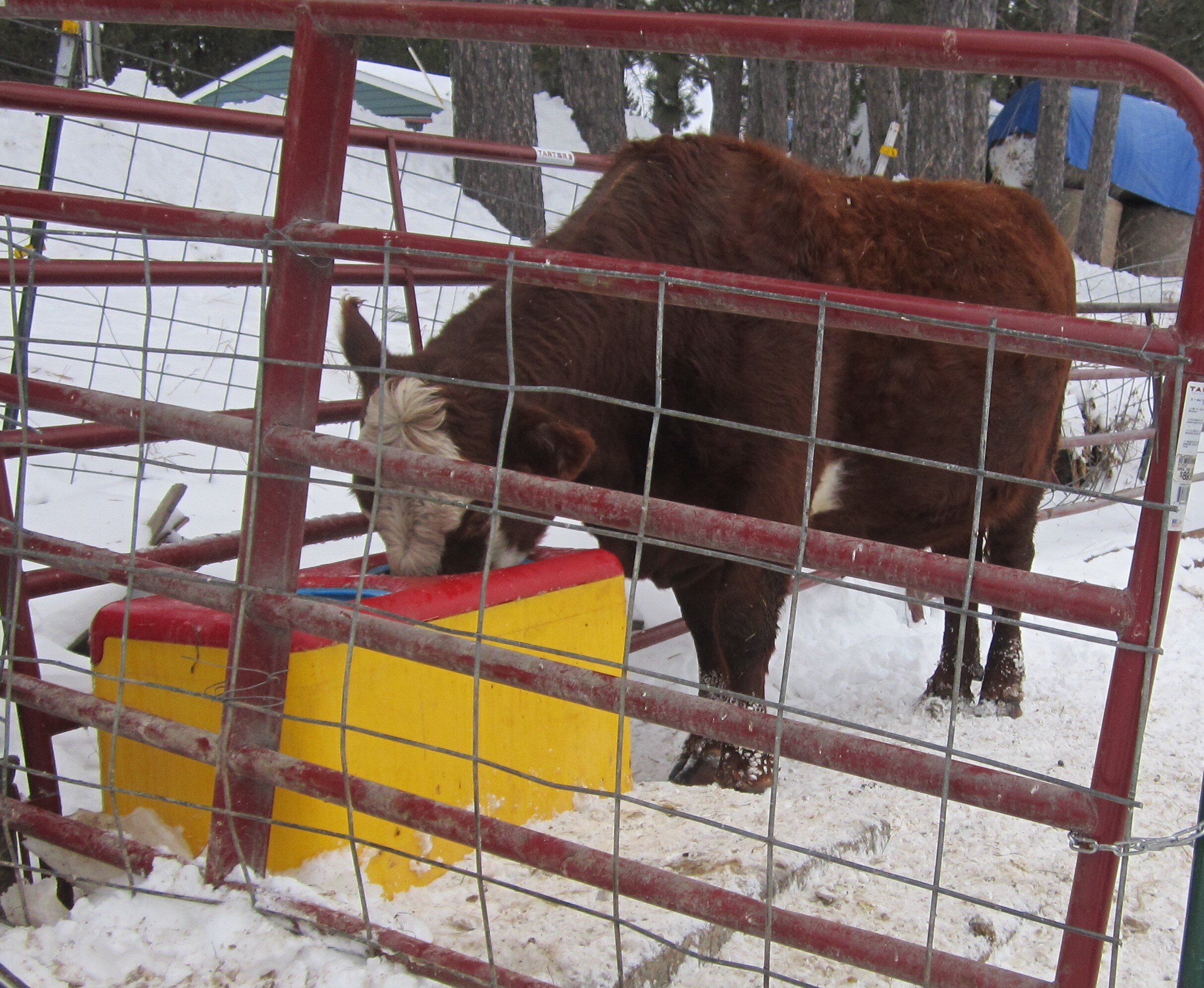“No mean animals at this farm,” Mary Ann tells me as I survey the cattle munching on hay in the snow. She and Shannon Wycoff have had this farm for 16 years. In that time, they’ve crossbred their original Limosins with Herefords. According to www.thecattlesite.com, “The Limousin has built a reputation for being The Carcase Breed. It produces beef with a low proportion of bone and fat, a top killing-out percentage and a high yield of saleable meat (73.3%).” And they were very popular here in the north when the Wycoff’s started. But, according to Mary Ann, those creatures were mean. And that didn’t work. Gradually, they’ve built a herd that is a Limosin-Hereford cross who appear to me to be pretty docile and friendly.
If you’d like to see happy cattle, check out the “Spring Fever” video of Shannon letting them out to fresh pasture after the winter last year. It’s on the blog at www.bearcreekacres.com and here https://www.youtube.com/watch?v=5i8uQIcqzQI&feature=emb_logo The horse who lives with them thinks he’s one of them and is the happiest of all to feel spring. The cattle spend winter in a huge pasture where Shannon places their hay at strategic points around the acreage, moving it every few weeks to a new spot. They fertilize the whole pasture and this way it grows their food the next summer. The Wycoff’s make some of their own hay, but buy quite a bit from other farmers. Summer 2020 was so dry that they had to travel the whole state to find hay.
The pigs are off in another direction in a huge pasture with quonset houses filled with hay. It’s chilly the day I arrive to visit and many of the 25 or so are snuggled inside. The rest are feeding—they eat a traditional mix of corn and soy from Widdes Feed, a third-generation family-run operation in Esko. The hogs are purchased as feeder pigs from a family-run operation in Park Rapids and are at least half Berkshire (the breed originated in Berkshire, England). I notice that all of the pigs have their tails—a key difference from confinement raised hogs whose tails are docked because they are so crowded that they will chew each other’s tails. These pigs have the run of many acres and don’t have to compete for space.
Shannon and Mary Ann added something new and innovative this fall with a micro-grant from Natural Harvest Food Coop in Virginia: a new watering system for the cattle and pigs. Up until this year, Shannon was filling huge water tanks twice each day from a well in the barn. And heating them with 1500-watt heaters which pulled a lot of power. The new Ritchie waterers are pretty amazing. According to the website, Ritchie—Fresh Water for Life, “The Pork King 1 is a single drink, durably designed, heated hog waterer using 304 stainless steel to withstand the rugged nature of a pen full of swine. Use in a single pen. Ideal for up to 40 hogs.” The hogs open the lid with their snouts and drink warm water whenever they’d like. This waterer and the cattle version, “The EcoFount 2 is an energy efficient double drink automatic waterer for horses or cattle…waters between 1-60 horses or beef,” are both connected by insulated hoses to the well in the barn. The hoses are protected by the Canadian company Heat-Line’s heat trace system which senses when the conduit needs heat and uses very little electricity. It’s a big improvement and energy savings over the traditional watering method!
Ritchie Hog Waterer provides constant warm water for pigs
And the cattle version
After I meet the cattle and hogs, we walk a bit of the farm with the two Wycoff dogs, as friendly as ever---remember, no mean animals here! Bear Creek runs through this 167 acres of dense woods and open pasture. The stately barn was completed in 1925 and the original house was built during the 1940’s by the Tom Saranpaa family who dug the entire basement by hand. It took them 10 years to build the house while they lived in the sauna. When the Wycoff’s bought the farm, it hadn’t been farmed for a long time. But Mary Ann discovered that the Saranpaas were still living in the area and invited them to visit. That’s when they learned about the hand-dug basement. The Saranpaas had dairy cows, then beef and turkey and potatoes. The root cellar for the potatoes is still here, along with the sauna.
The sauna, where the original farmers lived while building a house
Bear Creek Acres is able to sell in retail outlets because they use two USDA processors. Lake Haven Custom Meat Processing is in Sturgeon Lake and McDonald Meats is in Clear Lake. Like these two, USDA processing facilities are several hours from most producers in northeast Minnesota. Meat processing in the northland is a bit of a challenge: area producers of chicken, pork and beef are experiencing a high demand for their products as a result, in part, of Covid 19 and its disruption of the national meat supply chain. And most of the processors in northeast Minnesota are booked all the way through 2021. There are three types of meat processing plants in Minnesota. 1)Custom processors are exempt and may be inspected up to four times per year by the Minnesota Department of Agriculture. Producers who use custom processors may only sell directly to individuals. All of the meat must be labeled “not for sale.” 2) Equal-to processors are under daily inspection by an MDA inspector who inspects the animals before and after slaughter. Meat from these processors can be sold wholesale or retail but only in Minnesota. They bear the stamp of state inspection. 3) USDA inspected plants are under continuous inspection with the animals inspected before and after slaughter by a USDA inspector. This meat can be sold wholesale or retail, within Minnesota or in other states. It bears the USDA stamp that we are familiar with. Most area livestock and poultry farmers are small-scale and sell directly to individuals rather than to retail outlets. But some, like Bear Creek Acres, also sell to retail outlets. And that requires the special processor.
If we, as meat consumers, want local meat to be available in retail stores in the area, it will require more USDA processing. The plans to expand meat processing at the Northeast Regional Corrections Center in Saginaw are addressing that need to some extent. If we’re willing to buy directly from the farmer, processors 1 or 2 above will work, but they’re all booked up. So in order to buy more local meat, our area needs more local processors. That’s a key part of building a local food system so that a geographic area can sustain itself within its own “foodshed.” And that’s a topic for a future Grown on the Range column.
Bear Creek Acres’ 1925 barn






